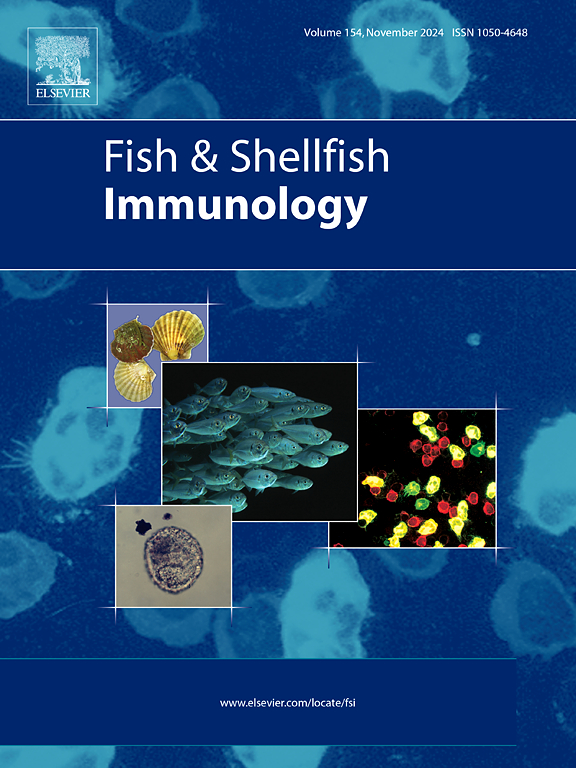Evolutionary analysis and immune-induced expression and m6A modification of RIPK1 and RIPK2 in the miiuy croaker
IF 3.9
2区 农林科学
Q1 FISHERIES
引用次数: 0
Abstract
Receptor Interacting Protein Kinases (RIPKs), including RIPK1 and RIPK2, are key mediators of inflammatory signaling and inflammatory cell death. In this study, we identified the RIPK1 and RIPK2 genes in the miiuy croaker (Miichthys miiuy) and analyzed their evolutionary conservation and structural characteristics using bioinformatics approaches, highlighting their potential immune functions. Notably, research on the role of N6-methyladenosine (m6A) modification in regulating RIPKs remains limited. Here, methylated RNA immunoprecipitation sequencing (MeRIP-seq) revealed significant m6A enrichment near the stop codons of RIPK1 and RIPK2 of Miichthys miiuy, which was further confirmed by MeRIP-PCR. Expression analyses showed that RIPK1 and RIPK2 were markedly upregulated after poly(I:C) and LPS stimulation. Interestingly, poly(I:C) increased the m6A modification level of RIPK1, whereas LPS reduced the m6A level of RIPK2. Moreover, treatment with the methylation inhibitor cycloleucine further elevated their expression. These findings suggest that m6A modification may participate in fine-tuning the immune regulatory networks involving RIPK1 and RIPK2, potentially modulating their expression dynamics in response to diverse immune stimuli. This work provides valuable insights into the epigenetic regulation of RIPK family members and offers a foundation for exploring m6A-mediated control of fish innate immunity.
小斑马鱼RIPK1和RIPK2的进化分析及免疫诱导表达和m6A修饰。
受体相互作用蛋白激酶(RIPKs),包括RIPK1和RIPK2,是炎症信号传导和炎症细胞死亡的关键介质。在这项研究中,我们鉴定了Miichthys miiuy (Miichthys miiuy)中的RIPK1和RIPK2基因,并利用生物信息学方法分析了它们的进化保守性和结构特征,突出了它们潜在的免疫功能。值得注意的是,关于n6 -甲基腺苷(m6A)修饰在调控RIPKs中的作用的研究仍然有限。在这里,甲基化RNA免疫沉淀测序(MeRIP-seq)发现Miichthys miiuy的RIPK1和RIPK2停止密码子附近有显著的m6A富集,MeRIP-PCR进一步证实了这一点。表达分析显示,poly(I:C)和LPS刺激后,RIPK1和RIPK2显著上调。有趣的是,poly(I:C)增加了RIPK1的m6A修饰水平,而LPS降低了RIPK2的m6A修饰水平。此外,甲基化抑制剂环亮氨酸进一步提高了它们的表达。这些发现表明,m6A修饰可能参与了RIPK1和RIPK2免疫调节网络的微调,可能调节它们在不同免疫刺激下的表达动态。这项工作为了解RIPK家族成员的表观遗传调控提供了有价值的见解,并为探索m6a介导的鱼类先天免疫控制奠定了基础。
本文章由计算机程序翻译,如有差异,请以英文原文为准。
求助全文
约1分钟内获得全文
求助全文
来源期刊

Fish & shellfish immunology
农林科学-海洋与淡水生物学
CiteScore
7.50
自引率
19.10%
发文量
750
审稿时长
68 days
期刊介绍:
Fish and Shellfish Immunology rapidly publishes high-quality, peer-refereed contributions in the expanding fields of fish and shellfish immunology. It presents studies on the basic mechanisms of both the specific and non-specific defense systems, the cells, tissues, and humoral factors involved, their dependence on environmental and intrinsic factors, response to pathogens, response to vaccination, and applied studies on the development of specific vaccines for use in the aquaculture industry.
 求助内容:
求助内容: 应助结果提醒方式:
应助结果提醒方式:


